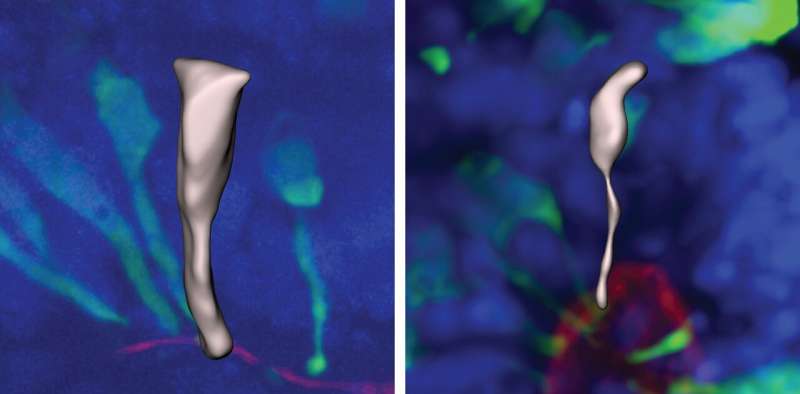The study, published in the journal Cell, compared ‘brain organoids’ – 3-D tissues grown from stem cells which model early brain development—that were grown from human, gorilla and chimpanzee stem cells.
Similar to actual brains, the human brain organoids grew a lot larger than the organoids from other apes.
[…]
During the early stages of brain development, neurons are made by stem cells called neural progenitors. These progenitor cells initially have a cylindrical shape that makes it easy for them to split into identical daughter cells with the same shape.
The more times the neural progenitor cells multiply at this stage, the more neurons there will be later.
As the cells mature and slow their multiplication, they elongate, forming a shape like a stretched ice-cream cone.
Previously, research in mice had shown that their neural progenitor cells mature into a conical shape and slow their multiplication within hours.
Now, brain organoids have allowed researchers to uncover how this development happens in humans, gorillas and chimpanzees.
They found that in gorillas and chimpanzees this transition takes a long time, occurring over approximately five days.
Human progenitors were even more delayed in this transition, taking around seven days. The human progenitor cells maintained their cylinder-like shape for longer than other apes and during this time they split more frequently, producing more cells.
This difference in the speed of transition from neural progenitors to neurons means that the human cells have more time to multiply. This could be largely responsible for the approximately three-fold greater number of neurons in human brains compared with gorilla or chimpanzee brains.
[…]
To uncover the genetic mechanism driving these differences, the researchers compared gene expression—which genes are turned on and off—in the human brain organoids versus the other apes.
They identified differences in a gene called ‘ZEB2’, which was turned on sooner in gorilla brain organoids than in the human organoids.
To test the effects of the gene in gorilla progenitor cells, they delayed the effects of ZEB2. This slowed the maturation of the progenitor cells, making the gorilla brain organoids develop more similarly to human—slower and larger.
Conversely, turning on the ZEB2 gene sooner in human progenitor cells promoted premature transition in human organoids, so that they developed more like ape organoids.
The researchers note that organoids are a model and, like all models, do not to fully replicate real brains, especially mature brain function. But for fundamental questions about our evolution, these brain tissues in a dish provide an unprecedented view into key stages of brain development that would be impossible to study otherwise.
Dr. Lancaster was part of the team that created the first brain organoids in 2013.
Source: Scientists discover how humans develop larger brains than other apes

Robin Edgar
Organisational Structures | Technology and Science | Military, IT and Lifestyle consultancy | Social, Broadcast & Cross Media | Flying aircraft


